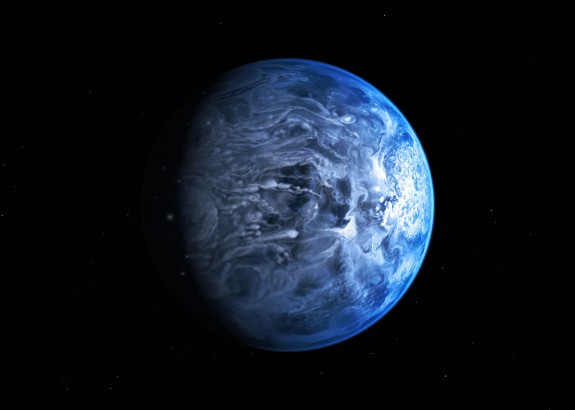Scientists Just Measured the True Color of a Far-Off Planet
For the first time, scientists have measured the color of a far off planet

The Pale Blue Dot, Earth as seen by Voyager 1. Photo: NASA / Voyager 1
Twenty three years ago and from 3.8 billion miles away the Voyager 1 probe turned and snapped a photo of Earth—the Pale Blue Dot. The photo showed our Earth as a speck in the dark sky—all of human existence wrapped up in a pixel.
Though the Earth is still all we’ve got, in recent years astronomers discovered potentially billions of other planets, many seemingly just like ours. Now, astronomers have found a new, simple parallel between one of these far-off planets and Carl Sagan’s famous blue dot, says the European Space Agency. For the first time ever, astronomers have directly measured the color of a planet in another solar system. And it’s blue—“a deep azure blue, reminiscent of Earth’s colour as seen from space,” says the ESA.
Pale Blue Dots parallelisms aside, though, the planet, HD 189733b, is more like Neptune’s evil twin than a distant Earth.
This “deep blue dot” is a huge gas giant orbiting very close to its host star. The planet’s atmosphere is scorching with a temperature of over 1000 degrees Celsius, and it rains glass, sideways, in howling 7000 kilometre-per-hour winds.

An artist’s rendering of the planet HD 189773b. Photo: NASA / ESA / M. Kornmesser
The planet orbits the star HD 189733 in the Vulpecula constellation, and to figure out its color, researchers used Hubble to measure the light coming from the star, both when the planet was in front and when it wasn’t. Looking at the subtle shifts in the color of the light let them figure out the color of the planet’s atmosphere.
More from Smithsonian.com:
You Can’t Throw a Rock in the Milky Way Without Hitting an Earth-Like Planet
This Is an Actual Photo of a Planet in Another Solar System
/https://tf-cmsv2-smithsonianmag-media.s3.amazonaws.com/accounts/headshot/smartnews-colin-schultz-240.jpg)
/https://tf-cmsv2-smithsonianmag-media.s3.amazonaws.com/accounts/headshot/smartnews-colin-schultz-240.jpg)